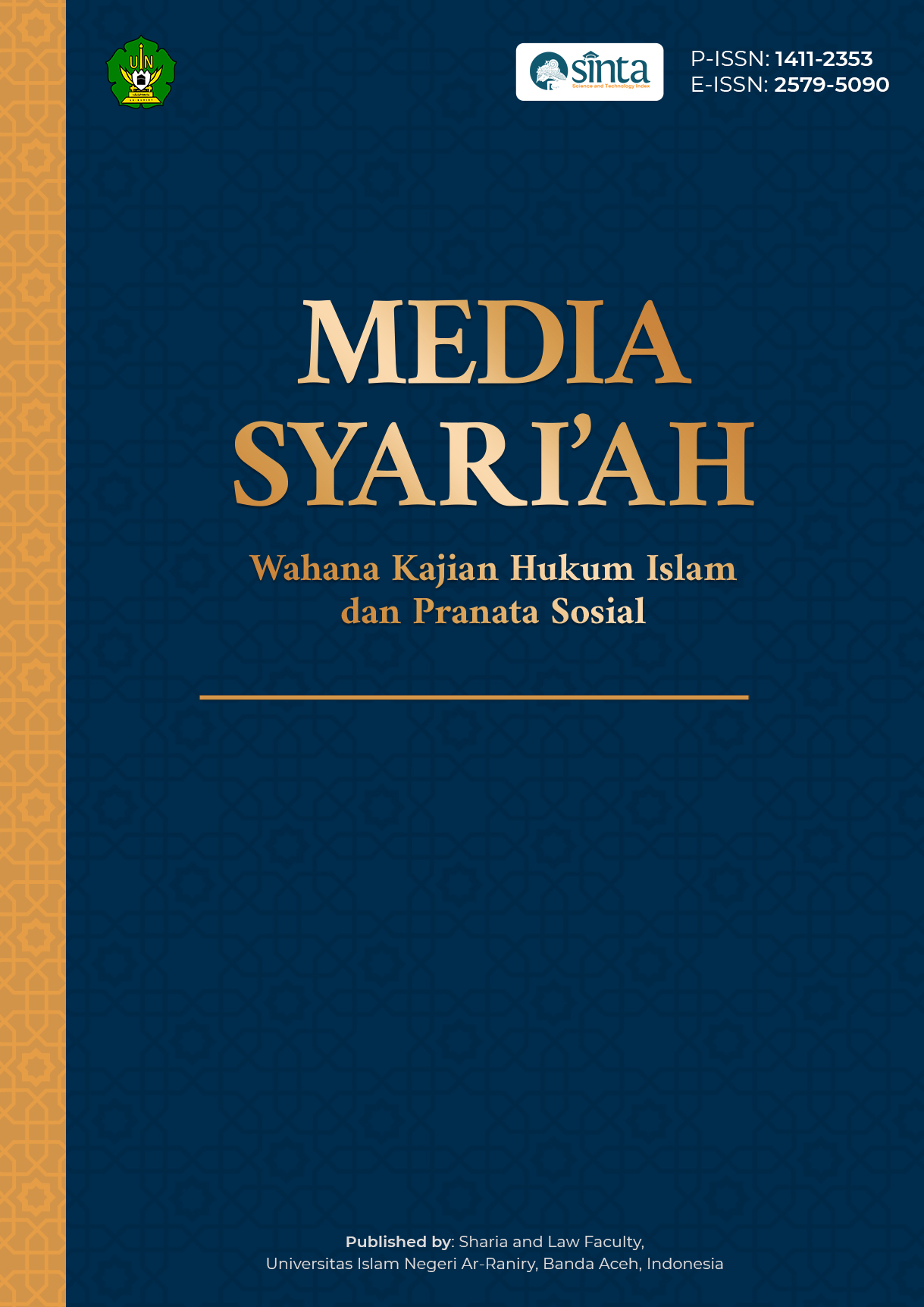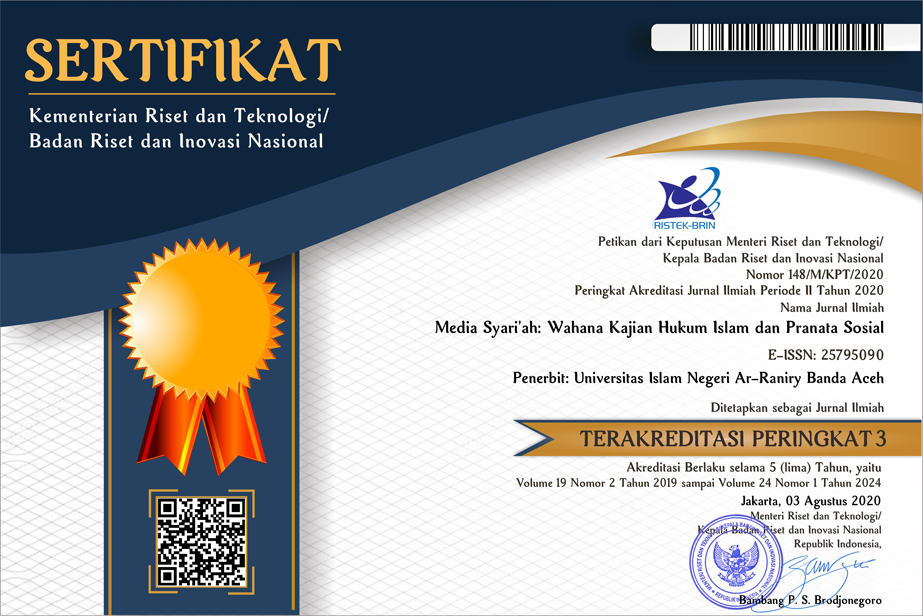Protection of Women in Aceh Qanun No. 6 of 2014 concerning Jinayah Law (Acehnese Perception Analysis)
DOI:
https://doi.org/10.22373/jms.v24i2.15380Abstract
The presence of Qanun jinayah is a blessing for Acehnese women. Therefore, it is the hope of all parties that the qanun can provide adequate protection for women. Several articles in Qanun no.6 of 2014 which regulate rape substantially encourage legal protection for women, including; with the stipulation that a person who deliberately commits rape is threatened with 'Uqubat Ta'zir flogging at least 125 (one hundred twenty five) times, a maximum of 175 (one hundred seventy five) times or a fine of at least 1,250 (one thousand two hundred and five) twenty) grams of pure gold, a maximum of 1,750 (one thousand seven hundred and fifty) grams of pure gold or imprisonment for a minimum of 125 (one hundred twenty five) months, a maximum of 175 (one hundred seventy five) months. Even if the rape is committed against children, the punishment is even more severe, namely being threatened with 'Uqubat Ta'zir flogging at least 150 (one hundred and fifty) times, a maximum of 200 (two hundred) times or a fine of at least 1,500 (one thousand five hundred) ) grams of pure gold, a maximum of 2,000 (two thousand) grams of pure gold or imprisonment for a minimum of 150 (one hundred and fifty) months, and a maximum of 200 (two hundred) months. Departing from the background of the problems above, this research is more focused on how the forms of women's protection in Qanun Aceh No. 6 of 2014 concerning Jinayah Law and what is the public's perception of the protection of women in the Qanun? The results of this study concluded that the existence of this qanun jinayah has not provided adequate protection for women. One of the reasons is the lack of socialization of the qanun jinayah and the lack of firmness by law enforcers in taking action against perpetrators. So that the perpetrators of harassment and rape are not afraid of the uqubat threat that has been stipulated for the perpetrators of criminal acts of harassment against women in the qanun jinayah.
Kehadiran Qanun jinayah adalah sebuah berkah bagi kaum perempuan Aceh. Oleh karenanya menjadi harapan semua pihak bahwa qanun tersebut dapat memberikan perlindungan yang memadai kepada kaum perempuan. Beberapa pasal dalam Qanun no.6 tahun 2014 yang mengatur tentang pemerkosaan secara substansi sangat mendorong perlindungan hukum terhadap perempuan diantaranya; dengan penetapan bahwa bagi orang yang dengan sengaja melakukan Jarimah Pemerkosaan diancam dengan „Uqubat Ta‟zir cambuk paling sedikit 125 (seratus dua puluh lima) kali, paling banyak 175 (seratus tujuh puluh lima) kali atau denda paling sedikit 1.250 (seribu dua ratus lima puluh) gram emas murni, paling banyak 1.750 (seribu tujuh ratus lima puluh) gram emas murni atau penjara paling singkat 125 (seratus dua puluh lima) bulan, paling lama 175 (seratus tujuh puluh lima) bulan. Bahkan jika pemerkosaan dilakukan terhadap anak-anak maka hukumannya lebih berat lagi, yaitu diancam dengan „Uqubat Ta‟zir cambuk paling sedikit 150 (seratus lima puluh) kali, paling banyak 200 (dua ratus) kali atau denda paling sedikit 1.500 (seribu lima ratus) gram emas murni, paling banyak 2.000 (dua ribu) gram emas murni atau penjara paling singkat 150 (seratus lima puluh) bulan, paling lama 200 (dua ratus) bulan. Berangkat dari latar belakang permasalahan di atas maka penelitian ini lebih difokuskan pada bagaimana bentuk-bentuk perlindungan perempuan dalam Qanun Aceh No. 6 Tahun 2014 tentang Hukum Jinayah serta Bagaimana persepsi masyarakat tentang perlindungan perempuan dalam Qanun tersebut?. Hasil dari penelitian ini menyimpulkan bahwa kehadiran qanun jinayah ini belum memberikan efek perlindungan yang memadai kepada perempuan. Salah satu sebabnya adalah kurangnya sosialisasi terhadap qanun jinayah tersebut dan kurang tegasnya penegak hukum dalam menindak pelaku. Sehingga para pelaku pelecehan dan perkosaan tidak merasa takut dengan ancaman uqubat yang telah ditetapkan bagi pelaku tindak pidana pelecehan terhadap perempuan di dalam qanun jinayah tersebut.
References
Abdillah, Masykuri, “Islam dan Hak Asasi Manusia : Pemahaman K.HAL. Ali Yafie.” dalam, Jamal D. Rahman, (ed.), Wacana Baru Fiqhi Sosial: 70 Tahun Ali Yafie, Cet. I; Bandung: Mizan, 1997.
Al Yasa‟ Abubakar, Syari’at Islam di Provinsi Aceh Paradigma Kebijakan dan Kegiatan, Banda Aceh: Dinas Syari‟at Islam Provinsi Nanggroe Aceh Darussalam, 2005.
Arskal Salim, Challenging The Seculer State: The Islamization of Law In Modern Indonesia, (Honolulu: University of Hawii Press, 2008).
Baltaji, Muhammad, Kedudukan Wanita dalam Al-Qur'an dan As-Sunnah, [Terj], Cet. I; Solo: Media Insani Publishing, 2007.
Bustami, Formalisasi Syari’at Islam di Nanggroe Aceh Darussalam, (Yogyakarta: Program Pascasarjana UGM Yogyakarta, 2003).
International Republikan Institut, Semiloka Pendidikan di Aceh: Persiapan Menyongsong Hari Depan, Jakarta, 2001.
Mahkamah Syar‟iyah, Himpunan Peraturan Peraturan Perundang-undangan tentang Mahkamah Syar’iyah di Provinsi NAD, Banda Aceh: Mahkamah Syar‟iyah, 2006.
Masykuri Abdillah (et.al), Formalisasi Syariat Islam di Indonesia: Sebuah Pergulatan yang Tak Pernah Tuntas, (Jakarta: Renaisan, 2005).
Murata, Sachiko, The Tao of Islam: Kitab Rujukan tentang Relasi Gender dalam Kosmologi dan Teologi Islam, Cet. II; Bandung: Mizan, 1997.
Ollenburger, Jane C., dan Helen A. Moore, Sosiologi Wanita, [Terj.], Cet. II; Jakarta: Rineka Cipta, 2002.
Redaksi Sinar Grafika, Undang-undang Pemerintahan Aceh (UU RI No. 11 Th. 2006), Cet. I; Jakarta: Sinar Grafika, 2006.
Rifyal Ka‟bah, Penegakan Syari’at Islam di Indonesia, (Jakarta: Khairul Bayan, 2004.
Rusjdi Ali Muhammad, Revitalisasi Syari’at Islam di Aceh: Problem, Solusi dan Implementasi Menuju Pelaksanaan Hukum Islam di Nanggroe Aceh Darussalam, (Jakarta: Logos Wacana Ilmu, 2003).
Shinta Dewi Rismawati, “Jurnal Penelitian”, Vol. 1, Nomor 1, November 2004.
Downloads
Published
Issue
Section
License
MEDIA SYARI'AH: Wahana Kajian Hukum Islam dan Pranata Sosial has CC-BY-SA or an equivalent license as the optimal license for the publication, distribution, use, and reuse of scholarly work. Authors who publish with this journal agree to the following terms:
1. Authors retain copyright and grant the journal right of first publication with the work simultaneously licensed under a Creative Commons Attribution-ShareAlike 4.0 International License that allows others to share the work with an acknowledgment of the work's authorship and initial publication in this journal.
2. Authors are able to enter into separate, additional contractual arrangements for the non-exclusive distribution of the journal's published version of the work (e.g., post it to an institutional repository or publish it in a book), with an acknowledgment of its initial publication in this journal.
3. Authors are permitted and encouraged to post their work online (e.g., in institutional repositories or on their website) prior to and during the submission process, as it can lead to productive exchanges, as well as earlier and greater citation of published work (See The Effect of Open Access).
You are free to:
Share — copy and redistribute the material in any medium or format.
Adapt — remix, transform, and build upon the material for any purpose, even commercially.
The licensor cannot revoke these freedoms as long as you follow the license terms.
All papers published in MEDIA SYARI'AH: Wahana Kajian Hukum Islam dan Pranata Sosial are licensed under a Creative Commons Attribution-ShareAlike 4.0 International License.




.png)


.png)
.png)
.png)



